JHI Biography
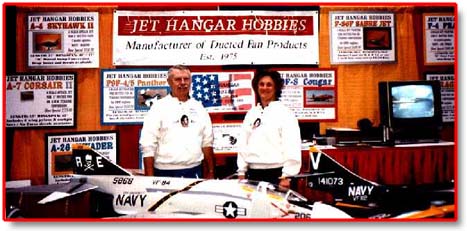 Larry
D. Wolfe, President of Jet Hangar International, Inc.,
has been in general aircraft modeling of over 40 years, and with
ducted fan modeling for approximately 35 years. As a helicopter
pilot, he has 10 years flight experience including 2 years of
duty in Vietnam where at the rank of Captain he accrued 2,000
combat flight hours. He has combined military and commercial flight
time totaling in excess of 4,500 hours. Larry's business partner
is his wife Cynthia Bertholf Wolfe. Cyndy, Chief Financial Officer
of Jet Hangar International, holds a Bachelor of Arts
degree in history from the University of New Mexico and a Master
of Science in Recreation from the University of Illinois. She
served two years in Vietnam as a Department of the Army civilian,
and has been active in Jet Hangar International Inc. since
1975. In addition, Cyndy is active in the community. She has managed
girls' softball teams, served on the Board of Directors of the
Weingart-Lakewood YMCA, is past President of the Artesia High
School Softball Boosters, and currently serves as President of
the Artesia Band Boosters. Cyndy has also been active as Board
of Education appointed representative to various ABC Unified School
District committees.
Larry
D. Wolfe, President of Jet Hangar International, Inc.,
has been in general aircraft modeling of over 40 years, and with
ducted fan modeling for approximately 35 years. As a helicopter
pilot, he has 10 years flight experience including 2 years of
duty in Vietnam where at the rank of Captain he accrued 2,000
combat flight hours. He has combined military and commercial flight
time totaling in excess of 4,500 hours. Larry's business partner
is his wife Cynthia Bertholf Wolfe. Cyndy, Chief Financial Officer
of Jet Hangar International, holds a Bachelor of Arts
degree in history from the University of New Mexico and a Master
of Science in Recreation from the University of Illinois. She
served two years in Vietnam as a Department of the Army civilian,
and has been active in Jet Hangar International Inc. since
1975. In addition, Cyndy is active in the community. She has managed
girls' softball teams, served on the Board of Directors of the
Weingart-Lakewood YMCA, is past President of the Artesia High
School Softball Boosters, and currently serves as President of
the Artesia Band Boosters. Cyndy has also been active as Board
of Education appointed representative to various ABC Unified School
District committees.
Larry's experiences with major aerospace firms have resulted
in new concepts involving the utilization of model aircraft applications
for use in full scale aircraft design.
Working with the Northrop Corporation in Hawthorne,
California, he constructed the proof-of-concept platoon-carrying
aircraft in 1/10 scale utilizing twin ducted fans and special
flaps incorporating a proprietary flap design so the aircraft
would have STOL capabilities. The project was conceived to prove
the concept of carrying a platoon-sized group and all support
equipment including jeeps from unimproved fields to destinations
over 1,000 miles. The aircraft was designed to provide a strike
force capacity into a combat situation.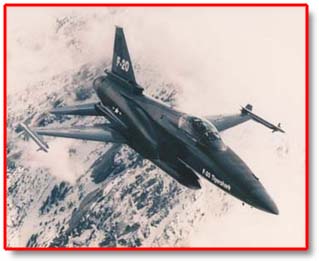
From 1982 to 1986 he developed the concept validating use of
radio control modeling in the development of full-scale advanced
and negative stability designs for aircraft. This specifically
involved the building and flying of two 100% 1/8 scale F-20 Tigersharks
which carried a Northrop designed $300,000 in-flight/computer
which measured 9 channels of information. Quantitative and qualitative
data was used for developing design and design changes in current
and future (not yet flown) aircraft designs. This concept proved
to cost approximately 1/10 that of traditional full scale methods.
During 1986 while under contract to DeVore Aviation
of Albuquerque, New Mexico, Larry constructed a 1/4 scale radio
controlled flying model of "Sunbird", an experimental
model used to develop a full-size aircraft for the general aviation
market. The model was built from drawings of the proposed full-scale
aircraft using a NASA designed airfoil.
Also during 1986, ACA Industries of Torrance, California
contracted with Larry to complete a defunct project of a diamond
wing (Joined Wing Concept) model with a 10' fuselage, 8' wingspan,
and weight of 23 lb. The first requirement was to refurbish and
restore a previously inadequate work/design to flyable state.
Extensive rework was necessary including refinishing of paint
work. All test flights prior to take-over by Jet Hangar
International had been unsuccessful due to problems with engines.
Consequently, there was a need to rework the improperly adjusted
engines and a successful test flight was made. However, in straight
and level flight, the left wing member from the dorsal to the
wing joint failed under compression loads, causing structural
failure of the wing.
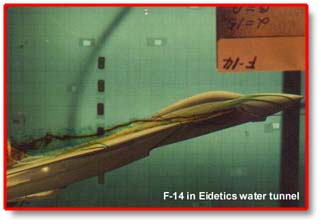 As a consultant
to Eidetics Corporation, Larry developed models to prove
design changes through water tunnel flow-visualization characteristics.
He engineered and constructed a series of water tunnels and water
tunnel models. These were supplied to California Institute of
Technology and the University of Taiwan.
As a consultant
to Eidetics Corporation, Larry developed models to prove
design changes through water tunnel flow-visualization characteristics.
He engineered and constructed a series of water tunnels and water
tunnel models. These were supplied to California Institute of
Technology and the University of Taiwan.
A "generic" water tunnel model allows multiple wing,
stabilizer, and dorsal design changes to investigate extremely
high angles of attack with relative wind. Because of the nature
of these tests, any further information on the purpose of this
model remains proprietary to Eidetics Corporation. This
process was used to re-engine 207 A-4C Skyhawks for the Republic
of Singapore. The study by General Electric Corporation proved
by the in the flow-visualization test that the existing intake
and duct liners to the face of the new engine would not need to
be changed. Based on these tests, a competitive bidder was denied
the contract based on their required inlet design changes.
While under contract with Ford Aerospace and Communications,
Larry engineered and constructed 4 scale models of the Hein D
helicopter for the Chaparral Missile Program in Europe. These
were designed to be target drones for instruction of military
personnel in the operation of missiles.
Concern with the environment also includes the model aircraft
industry, and in that arena Jet Hangar International is
no exception. In 1984 Aerospace Corporation contracted
with Larry to conduct a program involved in collection of data
on pollutants in the air by flying radio controlled aircraft through
the atmosphere.
Aerodynamic forces affect a model aircraft in the very same
way as they affect full scale aircraft. Dynamic Engineering
Inc. during 1982 contracted Larry to build a radio controlled
1/8 scale Piper Tomahawk featuring a full flying stabilizer that
rotated 90 degrees to the relative wind. This type research investigated
"deep stall" phenomena. The process involved the total
departure from flight with the ability to maintain control of
the aircraft during its vertical descent.
Preserving aircraft for enjoyment in later years is a requirement
for many museums and corporations. Larry has completed Static
Model Restoration for the following:
Douglas Museum at Santa Monica Airport, restored an
F-4D Skyray for United States Air Force, Wright-Patterson Air
Force Base, Dayton, OH, restored and repainted an F-15 Eagle
to new specifications and for the Vought Corporation (A Division
of LTV), restored an A-7D Corsair II research model.
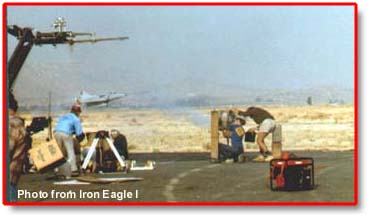 Larry
has also developed and created models used in the Hollywood Film
Industry. His credits include "Weird Science"
(1995) where he developed and created 5 model aircraft
to match the script parameters for blue screen and actual flight
sequences. In "Hot Shots" (1991) he created all
F-5 and Foland Gnat miniature aircraft used in the movie production.
These aircraft were used in concert with blue screen special effects.
Larry has also done international film work. For "Novela"
(1990), a requirement for Mexican television series was to
build and fly 1/8 scale Lear jet. The script required the dangerous
task of crash landing the jet while flying it toward the camera.
"Iron Eagle II" (1988) required Larry to provided
7 miniature aircraft--1 F-4, 2 F-16's and 4 KFIR's for special
effects. A special requirement included filming of flight shots
of models carrying pyrotechnics including in-flight explosion
of an aircraft on cue. For "Shannon's Deal" (1987),
Larry provided all aircraft for specific museum shots comprised
of approximately 20 model aircraft from WWII to present. One of
the most popular movies involving aircraft is "Iron Eagle"
(1985). Larry developed 6 radio control aircraft, one Cessna
152, three IAI KFIR models, and two General Dynamics F-16B's for
special effects. The F-16's were created in 1/10 scale, per requirements
of Falcons Flight. They were rigged to fire sidewinders, maverick
missiles, and drop bombs, in addition to being flown. They were
further rigged to be destroyed using radio control pyrotechnics.
The KFIR models were built using "Jet Hanger International"
kits and were also rigged to fire ordnance. One of the most popular
movies of all time is "Top Gun" (1985). Larry
developed and coordinated the construction of plugs and fiberglass
molds for 1/13.5 scale F-5E Tiger II and 1/10 scale F-14 Tomcat
(with swing wing capability) for Paramount Studios. The original
intent was for these models to be flown by radio control. Ultimately
the special effects were assumed by USFX. Larry designed and engineered
the special aircraft for the movie "Firefox" (1981).
He designed internal engineering on a script aircraft which proved
to have poor aerodynamics. The challenge of making if fly was
overwhelming and despite these odds, the Jet Hanger International
design flew satisfactorily. The flight sequences were done by
Larry in Thule, Greenland, as part of the film crew for filming
of the special effects.
Larry
has also developed and created models used in the Hollywood Film
Industry. His credits include "Weird Science"
(1995) where he developed and created 5 model aircraft
to match the script parameters for blue screen and actual flight
sequences. In "Hot Shots" (1991) he created all
F-5 and Foland Gnat miniature aircraft used in the movie production.
These aircraft were used in concert with blue screen special effects.
Larry has also done international film work. For "Novela"
(1990), a requirement for Mexican television series was to
build and fly 1/8 scale Lear jet. The script required the dangerous
task of crash landing the jet while flying it toward the camera.
"Iron Eagle II" (1988) required Larry to provided
7 miniature aircraft--1 F-4, 2 F-16's and 4 KFIR's for special
effects. A special requirement included filming of flight shots
of models carrying pyrotechnics including in-flight explosion
of an aircraft on cue. For "Shannon's Deal" (1987),
Larry provided all aircraft for specific museum shots comprised
of approximately 20 model aircraft from WWII to present. One of
the most popular movies involving aircraft is "Iron Eagle"
(1985). Larry developed 6 radio control aircraft, one Cessna
152, three IAI KFIR models, and two General Dynamics F-16B's for
special effects. The F-16's were created in 1/10 scale, per requirements
of Falcons Flight. They were rigged to fire sidewinders, maverick
missiles, and drop bombs, in addition to being flown. They were
further rigged to be destroyed using radio control pyrotechnics.
The KFIR models were built using "Jet Hanger International"
kits and were also rigged to fire ordnance. One of the most popular
movies of all time is "Top Gun" (1985). Larry
developed and coordinated the construction of plugs and fiberglass
molds for 1/13.5 scale F-5E Tiger II and 1/10 scale F-14 Tomcat
(with swing wing capability) for Paramount Studios. The original
intent was for these models to be flown by radio control. Ultimately
the special effects were assumed by USFX. Larry designed and engineered
the special aircraft for the movie "Firefox" (1981).
He designed internal engineering on a script aircraft which proved
to have poor aerodynamics. The challenge of making if fly was
overwhelming and despite these odds, the Jet Hanger International
design flew satisfactorily. The flight sequences were done by
Larry in Thule, Greenland, as part of the film crew for filming
of the special effects.
Larry worked with UCLA/Boeing and NASA developing
and constructing a prototype ultralight aircraft for use as telecommunication
relay platforms for cellular communications. The aircraft designated
"The SPFF" would fly in formation (one following the
other to take advantage of upwash created by the preceeding aircraft)
with other UAV'S on preplanned routes above cities. The prototype
UAV has a 44-foot wing span and is constructed of tubular spars
and graphite-epoxy ribs covered with mylar. The SPFF has an inverted
V-tail attached to a tubular fuselage and a payload compartment
located below the center of the wing span. Also, a pusher prop
was mounted 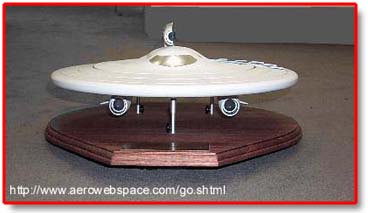 aft of the
V-tail. The UAV was successfully flight tested at El Mirage Dry
Lake in the Mojave Desert in California on November 19, 1996.
aft of the
V-tail. The UAV was successfully flight tested at El Mirage Dry
Lake in the Mojave Desert in California on November 19, 1996.
Larry has also worked with VTOL (Vertical Takeoff or
Landing) aircraft. Just recently, Larry has completed work on
a research lift fan for GO Aircraft Ltd. GO Aircraft
Ltd. is developing a patented, very high speed VTOL aircraft
concept that is twice as fast with more than double the range
of any VTOLs flying today. The High Speed Vertical Takeoff and
Landing (HSVTOL) aircraft is a patented aircraft concept, that
can be applied to a variety of aircraft sizes and missions, both
military and civilian. More information about this exciting new
aircraft can be viewed at http://www.aerowebspace.com/go.shtml
Currrently, Larry is residing at home and focusing all of his
efforts towards Jet Hangar Hobbies, Inc.
 Larry
D. Wolfe, President of Jet Hangar International, Inc.,
has been in general aircraft modeling of over 40 years, and with
ducted fan modeling for approximately 35 years. As a helicopter
pilot, he has 10 years flight experience including 2 years of
duty in Vietnam where at the rank of Captain he accrued 2,000
combat flight hours. He has combined military and commercial flight
time totaling in excess of 4,500 hours. Larry's business partner
is his wife Cynthia Bertholf Wolfe. Cyndy, Chief Financial Officer
of Jet Hangar International, holds a Bachelor of Arts
degree in history from the University of New Mexico and a Master
of Science in Recreation from the University of Illinois. She
served two years in Vietnam as a Department of the Army civilian,
and has been active in Jet Hangar International Inc. since
1975. In addition, Cyndy is active in the community. She has managed
girls' softball teams, served on the Board of Directors of the
Weingart-Lakewood YMCA, is past President of the Artesia High
School Softball Boosters, and currently serves as President of
the Artesia Band Boosters. Cyndy has also been active as Board
of Education appointed representative to various ABC Unified School
District committees.
Larry
D. Wolfe, President of Jet Hangar International, Inc.,
has been in general aircraft modeling of over 40 years, and with
ducted fan modeling for approximately 35 years. As a helicopter
pilot, he has 10 years flight experience including 2 years of
duty in Vietnam where at the rank of Captain he accrued 2,000
combat flight hours. He has combined military and commercial flight
time totaling in excess of 4,500 hours. Larry's business partner
is his wife Cynthia Bertholf Wolfe. Cyndy, Chief Financial Officer
of Jet Hangar International, holds a Bachelor of Arts
degree in history from the University of New Mexico and a Master
of Science in Recreation from the University of Illinois. She
served two years in Vietnam as a Department of the Army civilian,
and has been active in Jet Hangar International Inc. since
1975. In addition, Cyndy is active in the community. She has managed
girls' softball teams, served on the Board of Directors of the
Weingart-Lakewood YMCA, is past President of the Artesia High
School Softball Boosters, and currently serves as President of
the Artesia Band Boosters. Cyndy has also been active as Board
of Education appointed representative to various ABC Unified School
District committees.

 Larry
has also developed and created models used in the Hollywood Film
Industry. His credits include "Weird Science"
(1995) where he developed and created 5 model aircraft
to match the script parameters for blue screen and actual flight
sequences. In "Hot Shots" (1991) he created all
F-5 and Foland Gnat miniature aircraft used in the movie production.
These aircraft were used in concert with blue screen special effects.
Larry has also done international film work. For "Novela"
(1990), a requirement for Mexican television series was to
build and fly 1/8 scale Lear jet. The script required the dangerous
task of crash landing the jet while flying it toward the camera.
"Iron Eagle II" (1988) required Larry to provided
7 miniature aircraft--1 F-4, 2 F-16's and 4 KFIR's for special
effects. A special requirement included filming of flight shots
of models carrying pyrotechnics including in-flight explosion
of an aircraft on cue. For "Shannon's Deal" (1987),
Larry provided all aircraft for specific museum shots comprised
of approximately 20 model aircraft from WWII to present. One of
the most popular movies involving aircraft is "Iron Eagle"
(1985). Larry developed 6 radio control aircraft, one Cessna
152, three IAI KFIR models, and two General Dynamics F-16B's for
special effects. The F-16's were created in 1/10 scale, per requirements
of Falcons Flight. They were rigged to fire sidewinders, maverick
missiles, and drop bombs, in addition to being flown. They were
further rigged to be destroyed using radio control pyrotechnics.
The KFIR models were built using "Jet Hanger International"
kits and were also rigged to fire ordnance. One of the most popular
movies of all time is "Top Gun" (1985). Larry
developed and coordinated the construction of plugs and fiberglass
molds for 1/13.5 scale F-5E Tiger II and 1/10 scale F-14 Tomcat
(with swing wing capability) for Paramount Studios. The original
intent was for these models to be flown by radio control. Ultimately
the special effects were assumed by USFX. Larry designed and engineered
the special aircraft for the movie "Firefox" (1981).
He designed internal engineering on a script aircraft which proved
to have poor aerodynamics. The challenge of making if fly was
overwhelming and despite these odds, the Jet Hanger International
design flew satisfactorily. The flight sequences were done by
Larry in Thule, Greenland, as part of the film crew for filming
of the special effects.
Larry
has also developed and created models used in the Hollywood Film
Industry. His credits include "Weird Science"
(1995) where he developed and created 5 model aircraft
to match the script parameters for blue screen and actual flight
sequences. In "Hot Shots" (1991) he created all
F-5 and Foland Gnat miniature aircraft used in the movie production.
These aircraft were used in concert with blue screen special effects.
Larry has also done international film work. For "Novela"
(1990), a requirement for Mexican television series was to
build and fly 1/8 scale Lear jet. The script required the dangerous
task of crash landing the jet while flying it toward the camera.
"Iron Eagle II" (1988) required Larry to provided
7 miniature aircraft--1 F-4, 2 F-16's and 4 KFIR's for special
effects. A special requirement included filming of flight shots
of models carrying pyrotechnics including in-flight explosion
of an aircraft on cue. For "Shannon's Deal" (1987),
Larry provided all aircraft for specific museum shots comprised
of approximately 20 model aircraft from WWII to present. One of
the most popular movies involving aircraft is "Iron Eagle"
(1985). Larry developed 6 radio control aircraft, one Cessna
152, three IAI KFIR models, and two General Dynamics F-16B's for
special effects. The F-16's were created in 1/10 scale, per requirements
of Falcons Flight. They were rigged to fire sidewinders, maverick
missiles, and drop bombs, in addition to being flown. They were
further rigged to be destroyed using radio control pyrotechnics.
The KFIR models were built using "Jet Hanger International"
kits and were also rigged to fire ordnance. One of the most popular
movies of all time is "Top Gun" (1985). Larry
developed and coordinated the construction of plugs and fiberglass
molds for 1/13.5 scale F-5E Tiger II and 1/10 scale F-14 Tomcat
(with swing wing capability) for Paramount Studios. The original
intent was for these models to be flown by radio control. Ultimately
the special effects were assumed by USFX. Larry designed and engineered
the special aircraft for the movie "Firefox" (1981).
He designed internal engineering on a script aircraft which proved
to have poor aerodynamics. The challenge of making if fly was
overwhelming and despite these odds, the Jet Hanger International
design flew satisfactorily. The flight sequences were done by
Larry in Thule, Greenland, as part of the film crew for filming
of the special effects.